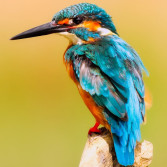Beautiful Beaks

Kingfishers can enter water without causing a splash.
Have you ever seen a kingfisher catch fish? Take a look, it is amazing.
Kingfishers need to enter water very fast in order to catch fish, but also enter the water carefully and as silently as possible, because the fish are sensitive and fast as well. As you can see in the video, kingfishers are quite successful. Their secret is the shape of their beak!
Activity/demonstration
This activity explores how different shapes interact with water as they enter it. Which shape do you think will create the largest or smallest splash?
- Gather a range of differently shaped objects e.g. sharp, square, round; different length and width as well. Include one shape that is long and conical, similar to a kingfisher’s beak (which must be dropped vertically, point first).
- Prepare a large bucket of water (10 litres is sufficient)...and maybe a few towels to clean up spillages.
- Before pupils drop the objects into the water ask them to predict which will cause bigger or smaller splashes.
- Ask pupils to agree a standard height to release each object into the water (20 cm will work fine). They will need to think about how to measure this consitently for each object.
- Drop the objects in to the water. Suggest that students take pictures or short videos to easily compare each objects interaction with water (slow motion videos will work best).
- What did they find in the 'splashing experiment'? Which shape had the most and the least splash?
- What are the other ideas and predictions of how each object will interact with water?

The image below shows the drag coefficients of different objects. The numbers show how easy an object can enter a new medium e.g. from air to water. The smaller the number is the easier the object enters a new medium.

Explanation
Scientists examined the splash and noise of the dives of all the 114 kingfisher species in the world. The European blue kingfisher was the 6th best diver on this list!
Simple explanation
Kingfishers’ beaks start as a small point and get bigger slowly and evenly. This enables them to enter water silently and without causing waves.
More detailed explanation
The gradually enlarging circumference of a kingfisher’s beak acts to part the water slowly, rather than 'shoving' water out of the way. This gives water time to move out of the way of the kingfisher, rather than fold over or 'bump' into adjacent water, which creates noise and splash.
How this helps the world
Learning from the beak of kingfishers is one of the most well-known examples of biomimicry. Japanese engineers developed the fastest train in the world in the 1960s, named the Shinkansen Bullet Train. It was very fast but coming out of a tunnel it caused a big noisy “explosion” as the train pushed air out of the tunnel. Eiji Nakatsu, the head engineer, was a birdwatcher and knew the fishing ability of kingfishers. Eiji predicted that as he and his colleagues tried out differently-shaped models for the train, the model most like a kingfisher’s beak would be quietest. After the train’s front end was redesigned with a shape much like a kingfisher’s beak, it proved to be much quieter, used 15% less energy to travel, and travelled 10% faster.

STEAM links
Some STEAM opportunities include:
- Identify the difference between the effects of air resistence, water resistence and fricion.
- Observing and raising questions about how different animals adapt.
- Analyse advantage and disadvantage of different adaptations/behaviours.
- Asking questions and making observations.
- Carrying out simple tests.
- Making predictions.
- Using scientific evidence to answer a question.
- Apply learning to real world problems.
Further Research
Read more about the kingfisher that inspired the bullet train (find out more) and read more about the train (find out more).
Cool Activities
Streams
How streamlined are birds? This activity allows pupils to tests different shapes and discover why animals adapt their shape.